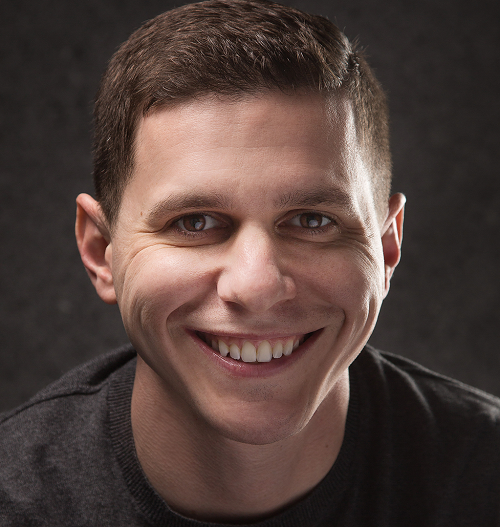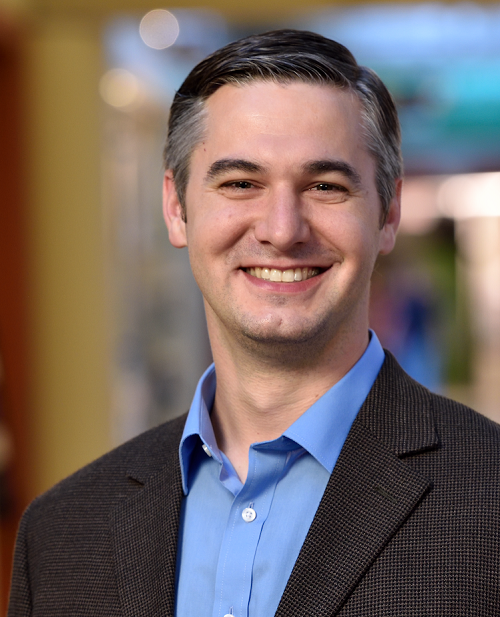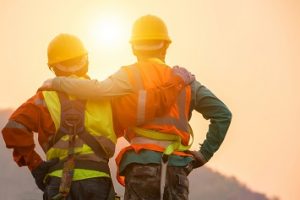It takes clear, regular communication to drive the employee engagement required to build and maintain an effective safety culture at any organization. This is especially true as we continue to adjust to the “new normal” during the COVID-19 pandemic, with organizations of all shapes and sizes operating on a wide spectrum of models, from having everyone in the workplace—following the appropriate guidelines, of course—to having everyone working from home and any number of hybrid models in between. To make this work, regardless of how your operations are currently structured, you need to have the technology in place to drive your connectivity needs.
On this episode of EHS on Tap, we spoke with Chris Borneo of MSA Safety and Matt DeLorenzo of Safety io, who will help break down how implementing the right technology can boost your connectivity, driving communication, engagement, and your overall safety program.
Prefer to listen? You can find the full podcast audio here.
Justin Scace: Hello, everyone, and welcome to EHS on Tap. I’m your host Justin Scace, senior editor of the EHS Daily Advisor, and we hope that all of our listeners are doing all they can to remain healthy and safe during the ongoing COVID-19 pandemic.
Now, even before a great many of us were working remotely, connectivity has been and will always be a key component of successful safety programs and healthy safety cultures. Open communication; engagement, from employees to executives; and effective change management all depend on connectivity. And technology can help facilitate all of these factors that contribute to effective EHS management. On today’s podcast, we’re chatting with two experts who can guide us through the practicalities of connectivity, the technology involved, and how it can serve to create better workplace safety programs.
Now, before we introduce them, I would like to take a moment to thank our sponsors for today’s episode: MSA Safety and Safety io. Established in 1914, MSA Safety Incorporated is the global leader in the development, manufacture, and supply of safety products that protect people and facility infrastructures. Safety io is a software-as-a-service subsidiary of MSA Safety—established in 2018—that creates safety tools that help improve its customers’ safety awareness and outcomes. For more information, visit http://www.msasafety.com and http://www.safetyio.com.
Now, I am excited to introduce our two guests for today’s show: Matt DeLorenzo and Chris Borneo. Matt has spent 11 years collaborating with industrial and fire service personnel around the world—first as an MSA Safety new product development team member and then as the business director of Safety io, where his primary goal is to identify and deliver services that help safety managers improve safety outcomes.
Chris has been at MSA for the past 10 years in roles that run the gamut from manufacturing operations to product management, with 5 of those years spent overseas on ex-pat assignment in Berlin, Germany. Today, he leads one of MSA’s product management teams focused on the development of connected wearable safety technology that raises the bar for safety programs around the globe. So, Matt and Chris, welcome, and thank you for joining us on EHS on Tap.
Chris Borneo: Thanks for having us, Justin.
Matt DeLorenzo: We’re excited to be here. Thanks so much.
Justin Scace: You’re very welcome. So, I shared a little bit about you and your introductions, but tell us a little bit more about yourselves. Who are you, and what are your roles?
Chris Borneo: Sure. My name is Chris Borneo, and like you mentioned, I’m the product group manager at MSA. So, I lead one of our product development teams there. And that product development team is really focused today on developing wearable gas-detection technologies that are starting to evolve into wearable safety technology devices—so starting to look and understand how we can better protect the worker from a technology perspective moving forward.
Matt DeLorenzo: And then from my perspective, Safety io has become a way that we can serve the MSA customer base in a unique way, providing solutions that tie the information that’s available from the devices that we sell to actionable outcomes, things that people can do to make it easier for them to manage their programs and to drive their programs forward into the future.
Justin Scace: That’s great. Thank you both for being here today. Chris, can you tell us a little bit more about the history of MSA Safety?
Chris Borneo: Yeah, definitely. As you mentioned, the company was founded in 1914, so we’re 106 years old now. And it’s pretty rare to hear about companies that are this old and still thriving like MSA is. We started out really in the mining market. So MSA traditionally stands for Mine Safety Appliances, and that first product was the electric cap lamp. And actually, our two founders developed that cap lamp in conjunction with Thomas Edison. So as a little bit of a fun fact, that’s where we started.
Justin Scace: Wow.
Chris Borneo: But we’ve had a lot of time to evolve and expand. So, what started as a cap lamp has turned into really a broad global product portfolio that really serves two primary markets, one being industrial and one being fire service.
So, in the industrial space, you have everything from hard hats, fall protection, and fixed to portable gas detection; on the fire service side, we are selling self-contained breathing apparatus for firefighters, fire helmets, and their turnout gear. So, it’s really broad across both of those segments of the industry.
Justin Scace: That’s great. Matt, can you share a little bit about Safety io?
Matt DeLorenzo: Of course, yeah. As you mentioned, we got our start a couple of years ago, and our goal has been to help safety management teams, and EHS teams in the industrial space, understand how they can get more from the devices that they have—in particular, the portable gas-detection devices today. How do they create an environment where they can drive greater uptime for those devices while also driving greater worker accountability? Because at the end of the day, they’re looking to get better behavioral safety practices advancing through their organization and a more personal accountability for those types of activities. And we’re here trying to help move that forward for them.
Justin Scace: That’s very interesting. So, it sounds like you’ve really recognized some shifts in these markets that you serve. Is that true? Is that a good assumption?
Chris Borneo: Yeah, that’s definitely true. One of the things is that safety programs are, by nature, conservative. It makes a lot of sense. And so typically, what we see is that any kind of technology really goes through a maturity phase and an acceptance phase outside of safety, and then finally, it makes its way there. This is especially true in the consumer world. And so, you’ve seen things like wearables, smart homes, smartphones, and connectivity; all of these things are really becoming ubiquitous in our everyday lives. But the safety world has been shielded from that due to that sense of conservativeness.
So now, as all of that is finally entering into that space, safety managers want to do things more efficiently, and they really want to pioneer a better safety program. And I think the reality that they’re waking up to is, wow, we can do so much better and so much more with technology on our side. And I think the pandemic and everything that we’ve experienced with remote tools and how they can make us more effective doing things when we’re not close together have really only accelerated some of that shift that we’re seeing.
Justin Scace: Great. So, let’s talk a little bit more about the specific audience that we’re talking to here—the EHS management space. What’s in it for them? How can they benefit from these changes that we’re experiencing—the market changes and also as technology advances?
Matt DeLorenzo: That’s a great question. I’ll take that one. When it comes to EHS management teams, they live a very interrupted, driven life in many cases. So, they have big goals that they want to accomplish at the safety level. They have these key performance indicators (KPIs) that are really important to them, but a lot of the daily activity is disrupted by surprises and things that they couldn’t have anticipated. And we’re all living directly through that on a macro level with the pandemic and downturns in certain markets.
But at the same time, at a micro level, they have all kinds of other things that they’re concerned about. So, when it comes to their big goals, they have these distractions that are really challenging them to be effective and to hit their larger KPIs. They want to be proactive, but they’re stuck being reactive as a result. Many of them have robust standard operating procedures around their safety programs, but they’re challenging to enforce because there are so many people and facets that create a challenging dynamic for them.
And they care about compliance. They’re looking to do more than compliance in most cases, but it’s really hard to keep up with all the different types of equipment and processes that they have to manage. And all of that coming together is a really challenging environment for them. So what Chris and I see, and what MSA sees in general, along with what we’re learning from the information that’s coming in through the Safety io services, is that there are really nice ways that technology can be leveraged to resolve these challenge points—these pain points, if you will—to really provide pain relief. And that’s aligned with what some of your previous guests have talked about.
You had an EHS management and recordkeeping and reporting conversation with some folks from Gensuite and other teams who talked about similar things. How can we make it easier with technology, with connectivity, without adding a bunch of overhead? And so, I think that’s where the implications are for the EHS management space. What are the tools that are available to help with managing these pain points?
Justin Scace: Absolutely. And clearly, all of this, the new technology, a lot of these changes are exciting. But as you spoke to a little bit, it can also be intimidating getting into this space. How or where would you encourage our listeners to start?
Matt DeLorenzo: Well, I think there are really three steps. Number one, I’d encourage them to define their vision for the future. Where do you want your safety program to be in 5 years? And then, acknowledge where you stand today. And what are the incremental things that you can be doing to improve? There are all kinds of questions you might ask yourself in the employee safety training and accountability space; in the safety equipment, maintenance, and compliance space; and in the data analysis, recordkeeping, and reporting spaces I mentioned earlier. So, there are multiple facets, and I think it’s a matter of prioritization. Which things help you get closer to that future state that you really desire?
The second step I would say is to start small. Focus on what’s practical and what will give you a quick win that proves the value of the connectivity that we’re talking about. What are those things within your space that give you the flexibility to provide meaningful and reasonable results? I guess Chris and I would be a bit biased. We would probably argue that portable gas detection is a great place to start because it’s something that doesn’t require a lot of decision-makers. It gives you immediate gratification in terms of driving compliance and management of tools and real-time monitoring of those devices. But pick something that makes sense for your program as a small start.
And then lastly, I would say also think big. You are going to need help. Identify some safety champions within your organization who can help effect a broader cultural change. Who are the colleagues? Who are the partners who will come alongside you in embracing the safety-first mind-set and be advocates alongside you, too, in this journey? Who are the leaders, if there’s one or two who you can stay connected to and show that you’re making progress in this way? And they could be champions from the top down. So, I would say those are the three big steps that I would focus on as a safety management team.
Justin Scace: That’s great. Now, speaking of the last step that you were just talking about—the big-picture organizational changes—I’d like to go back to Chris for a moment. I read your mission statement for MSA Safety that men and women may work in safety and that they, their families, and their communities may live in health throughout the world. Now, that’s a great mission. But what does it look like for, as you mentioned, a 106-year-old company to continue to fulfill that mission in the modern times, a time of so much change?
Chris Borneo: That’s a good question. And I think one of the realities of that mission statement is that for 106 years, it hasn’t had to change. We’re continuing to live up to that and to strive for that. And so even though solving the modern-day problems is different today, the mission stays intact. So, when we look at that, we’re constantly going back to that and saying, “This mission is constant.”
So, what do we need to change ourselves intentionally to keep upright, to keep up with the expectations of our customers? And I think it’s been really important for us to continue to recognize and understand what makes us successful and what the key enablers are that make us different from any of our competitors and leverage that to better understand where we want to be in the future and how we can elegantly get there.
So, when we’re looking at the industrial space, we’re working on a program that we call Connected Work. And really, Connected Work is all about bringing together everything that Matt’s talking about on the Safety io side and then everything that I’m talking about on the hardware and wearable technology side so that you have all of these tools and analytics and seamless integration of industrial internet of things (IIoT) devices that, at the end of the day, allow you to work safer, allow you to work smarter, and make it so that it’s able to be tackled reasonably.
I think one of the things, when we talk about our customers and what they can do with their safety programs and with everything that we’re offering, is that it’s all about a journey. You need to start small and start making progress. There is no solution out there that, overnight, you can flip the switch from analog to digital. And MSA internally is on that same type of journey.
So for Connected Work, we have four key focus areas. They’re automated compliance management; incident prevention and management response; worker health and productivity; and then finally, active safety monitoring. And those are the goalposts that we’re using to guide us over the next several years.
Justin Scace: So those four areas, those categories—could you dive into each of those just a little bit for me? What things are behind them?
Chris Borneo: Yeah, absolutely. There’s obviously a lot of detail around each of those. But just to hit on them at a high level, automated compliance management—what this is about is that safety programs, the hardware, the devices, and the equipment that they have today all creates complexity and burden to be able to manage that. Whether it’s inspecting devices, bump testing, or calibrating them, they all take up time to basically just sustain the level of safety that you’re currently at. So automated compliance management is really about taking those products and adding some smarts and technology into them so that we can take that burden off of them and allow technology to handle that compliance itself.
The next one is incident prevention management response. The Holy Grail, obviously, is that you prevent every single incident. And so, when we look long term, that’s obviously what we’re trying to get to. And we think there’s a tremendous amount of opportunity there with data analytics. So now you have smart devices, and you have cloud software applications that we can bring together in a really nice way and leverage those data to be able to prevent a lot of incidents. But obviously, getting there is going to take some time. So, whenever we look at the incident management and response piece, we want to better enable safety programs through real-time connectivity and better visibility of their worksites and allow them to follow up more efficiently on incidents so that they have all of the information that they need at their fingertips and documented from a compliance perspective.
The third one was worker health and productivity. So, what we’re doing there is taking a harder look at the workers and better understanding how technology can allow them to be safer. And when you start to think about it, you realize that what they’re protected with today from a safety perspective is great, but there’s so much opportunity to do a better job with technology moving forward.
Then the fourth component is active safety monitoring. And the best way to look at this is giving those safety managers a set of eyes everywhere at all times so that they’re not constantly feeling like they need to be walking through a facility to understand how effective their safety program is being implemented. That’s a mouthful, but those are the four big categories that we’re focused on.
Justin Scace: Very interesting. So where did you start this whole journey along all these categories? And how can these apply to EHS management teams who are looking to embrace new tools and technology, the sorts that you’re describing right now?
Matt DeLorenzo: It’s been a journey for us, just like it has been and will continue to be for the EHS managers. And how we’ve started is looking at the things that MSA offers from a device perspective. We’ve got portable gas detection, fixed gas and flame—everything that Chris mentioned earlier on in the program. And determining, alright, where are the places that information or data can come from that we can use and employ to help those safety managers?
Portable gas detection, as I mentioned earlier, is an ideal place for us because they are electronic devices that already do some data logging and contextual collection of information that you can then share with EHS teams so that they can, again, drive that behavioral safety accountability that they’re looking for; drive the compliance that they’re looking for; and, ultimately, lead to greater uptime with that part of their program.
MSA is also looking more broadly across this portfolio and has added to its portfolio. In 2018, MSA acquired an organization called Sierra Monitor, and they have, in addition to their fixed gas and flame solutions, a gateway that allows for their devices to connect to cloud-hosted solutions. So MSA is then considering: What are the implications for safety management teams as you look beyond portable gas detection with technologies like that? And I’d say the same for any of the other product verticals in MSA’s portfolio.
The fall protection, head protection, and respiratory protection space—how can we take meaningful steps to incorporate that information into one place so that safety management teams can grow steadily into managing more and more of their programs with an approach from MSA and from Safety io? So it’s been a journey for sure for us and similar to what EHS is going through right now, and we do try to be careful to listen well to what safety management teams are telling us so we can deliver the things that have the most impact as quickly as possible.
Justin Scace: Absolutely. Now, one thing that I think Matt mentioned awhile ago was starting small—thinking big but smart but starting small. But even with starting small, I imagine that there have been some bumps along the way toward arriving at all of these technological solutions and providing greater connectivity. So, what’s that looked like for you? And how are you overcoming them? What might our listeners encounter on their journey as they’re seeking to adopt new technological solutions for their EHS program?
Matt DeLorenzo: That’s a great question. And as you can imagine, MSA is 106 years old, and we serve a relatively conservative customer base. So to launch an organization in 2018 like Safety io as a software subsidiary that’s very different from what MSA traditionally focuses on—there are certainly hurdles to overcome internally and externally. We have the benefit of having a tremendous leadership team who have supported the creation of this organization and the things that need to be done internally to ensure the success of both MSA and Safety io together.
Like I mentioned earlier, there are going to be cultural changes within the safety program and within the customer organizations. We’ve faced the same things. So, what I would say is understand the challenges you might face, keep your eyes open to opportunities to bring people alongside you, and knock out those challenges one by one. Know where you’re going to focus and why, find those champions, and train the champions. Communicate your story as well as you can, and be willing to pivot where that makes sense as you learn and grow.
It’s really problem-solving 101, but when you apply it and it involves relationships and people whom you’ve been working with for a long time, you can ruffle some feathers. But I think at the end of the day, if you have the right people by your side, you can make a tremendous amount of progress in a short amount of time.
Justin Scace: Absolutely. That makes perfect sense. We’re talking about all of these technological disruptions and management of change. So, let’s look to the future. What’s next? Where does all of this lead for EHS programs and for worker and worksite safety?
Chris Borneo: I’ll take that one. I think it’s a huge opportunity for all of us, and I think it’s up to each of us to determine what we can make out of all of this. What we see at MSA is that it’s a huge opportunity to differentiate safety programs. And so there are going to be some safety programs that cling to the status quo and what has been good enough over the past. But there are going to be other safety programs that are looking to the future and saying, “Wait a second. With all of this technology, with all of this software and everything at my fingertips now, I can do so much better.”
I think you’re going to start to see a shift and a spread among those two different groups of EHS professionals. So what we’re trying to do is make sure that we’re developing solutions that align with looking toward the future and better enabling those EHS programs to continue plowing their way forward because we still think that there’s just so much more upside when we look at the number of incidents that still occur on a daily basis on any given worksite.
Justin Scace: That’s great. It sounds like there are a lot of things to look forward to on this front, and you guys have provided a lot of great insights for our EHS audience today. So thank you again, Chris and Matt, for joining us today on EHS on Tap.
Chris Borneo: Thanks, Justin.
Matt DeLorenzo: Thank you very much.
Justin Scace: You’re very welcome. Now, we’d also like to, once more, thank MSA Safety and its subsidiary, Safety io, for sponsoring today’s episode. For more information, please be sure to visit www.msasafety.com and www.safetyio.com.
And to our listeners, please keep an eye out for new episodes of EHS on Tap. And keep reading the EHS Daily Advisor to stay on top of your safety and environmental compliance obligations, get the latest in best practices, and keep your finger on the pulse of all things related to the EHS industry. Until next time, this is Justin Scace for EHS on Tap.
 Chris Borneo has been at MSA for the past 10 years in roles that run the gamut from manufacturing operations to product management, with 5 of those years spent overseas on expat assignment in Berlin, Germany. Chris holds his bachelor’s degree in industrial engineering from the University of Pittsburgh and his MBA from Carnegie Mellon University. Today, he leads one of MSA’s product management teams focused on the development of connected wearable safety technology that raises the bar for safety programs around the globe. Chris Borneo has been at MSA for the past 10 years in roles that run the gamut from manufacturing operations to product management, with 5 of those years spent overseas on expat assignment in Berlin, Germany. Chris holds his bachelor’s degree in industrial engineering from the University of Pittsburgh and his MBA from Carnegie Mellon University. Today, he leads one of MSA’s product management teams focused on the development of connected wearable safety technology that raises the bar for safety programs around the globe. |
 Matt DeLorenzo has spent 11 years collaborating with industrial and fire service personnel around the world, first as an MSA new product development team member and then as the business director of Safety io, an MSA software service subsidiary. His primary goal at Safety io is to identify and deliver services that help safety managers improve safety outcomes. Matt DeLorenzo has spent 11 years collaborating with industrial and fire service personnel around the world, first as an MSA new product development team member and then as the business director of Safety io, an MSA software service subsidiary. His primary goal at Safety io is to identify and deliver services that help safety managers improve safety outcomes. |
EHS on Tap is an environmental, health, and safety podcast by BLR’s EHS Daily Advisor. On each episode of EHS on Tap, our host will discuss emerging legal, regulatory, and policy issues with industry experts and the impacts to everyday safety and environmental professionals. EHS on Tap topics run the gamut of contemporary issues facing EHS managers and professionals today. Download the podcasts on iTunes here, and also be sure to visit our SoundCloud page for a full listing of all of our episodes!




